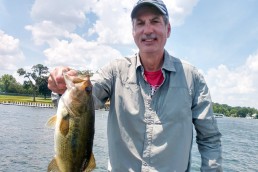Buzzin’ for Bigmouths
SHARE THIS POST
If you’re topwater fishing for largemouth bass this summer, Phil Piscitello recommends buzzbaits to cover water, provoke aggressive strikes and put nice bass in the boat.
There are many styles, sizes and colors of buzzbaits, including single- and double-bladed as well as inline buzzbaits. The classic inline buzzbait can be used in semi-heavy cover. A single hook and a weed guard help it come through cover. (Blue Fox made the classic Floyd’s Buzzer. One thing about inline buzzers: You must reel fast to keep them up on the surface. When the fish are aggressive, inlines produce aggressive strikes and catch nice fish. Fish the bait through the outer fringes of lily pad fields or reed beds. They also catch their share of toothy critters like northern pike and muskies.
For most buzzbait situations, the single buzz is the way to go. You can cover a lot of water and find active fish. You can fish them around shoreline cover such as fallen timber, boat docks, boat lifts, seawalls, overhanging trees and all sorts of weed cover.
There are mini versions available in 1/8-ounce, which work really well in pre-spawn, spawn and post-spawn situations. These tiny morsels have a subtle sound that is perfect in early season. Despite their small size, they can really catch nice-sized bass.
Day-in and day-out, the standard size model is the way to go. The 1/4-, 3/8-, and 1/2-ounce models consistently put the most fish in the boat. You may need to play with size and color to fine-tune the bite as you go.
Are you enjoying this post?
You can be among the first to get the latest info on where to go, what to use and how to use it!
The sound a buzzbait makes can also be a factor. Some are relatively quiet; other models are quite noisy. Some blades have a “clacker,” which is nothing more than a metal flap that rides on the shaft and makes contact with the blade as it rotates. This sound can be very appealing to a bass and triggers lots of fish. On other models, the blade contacts the lead head, which also produces aggressive strikes. The Cavitron by Lucky Strike is designed with holes in the blade. This gives the bait a different sound, which is very effective some days. The Cavitron can be retrieved very slowly and still stay on the surface; that can really put nice bass in the boat.
As buzzbaits get used a lot and the blade starts to wear, they start to produce a squeaking sound; the more the bait squeaks, the more fish it starts catching. With some tinkering, you can get your bait to start squeaking right away. The first thing you need to do is crimp the rivet on the end of the shaft so it can’t rotate. Next, take a pliers and rough up the flat surface on the rivet. Next, as you are traveling from spot to spot in your boat, have your partner hold the buzzbait up in the wind, so the blade rotates at a high rate of speed. This will cause the blade to wear into the rivet and produce that deadly squeaking sound. Some guys even tie them to their side view mirror of their vehicle and have them spin as they are driving to the lake. When they arrive, their buzzbaits are good to go.
Buzzbait fishing is an extremely effective and exciting presentation to putting a lot of nice bass in your boat, along with some lunkers. Add buzzbaiting to your bass fishing arsenal and you will catch more bass.
Looking for more ways to increase your catch rate? You’ll find plenty of suggestion in every issue of MidWest Outdoors. Subscribe on our website.
MWO
SHARE THIS POST
You may also like...
Nothing found.
Did you enjoy this post?
You can be among the first to get the latest info on where to go, what to use and how to use it!
Phil Piscitello
Phil Piscitello has 45 years of experience as a multispecies angler on ice and open water. He is a fishing guide, master charter captain and seminar speaker guiding in northern Illinois and southern Wisconsin. Picitello is also a regular guest on Chauncey’s Great Outdoors radio show and MidWest Outdoors TV show. He has fished all five Great Lakes and many major rivers, lakes, and reservoirs throughout the Midwest.
